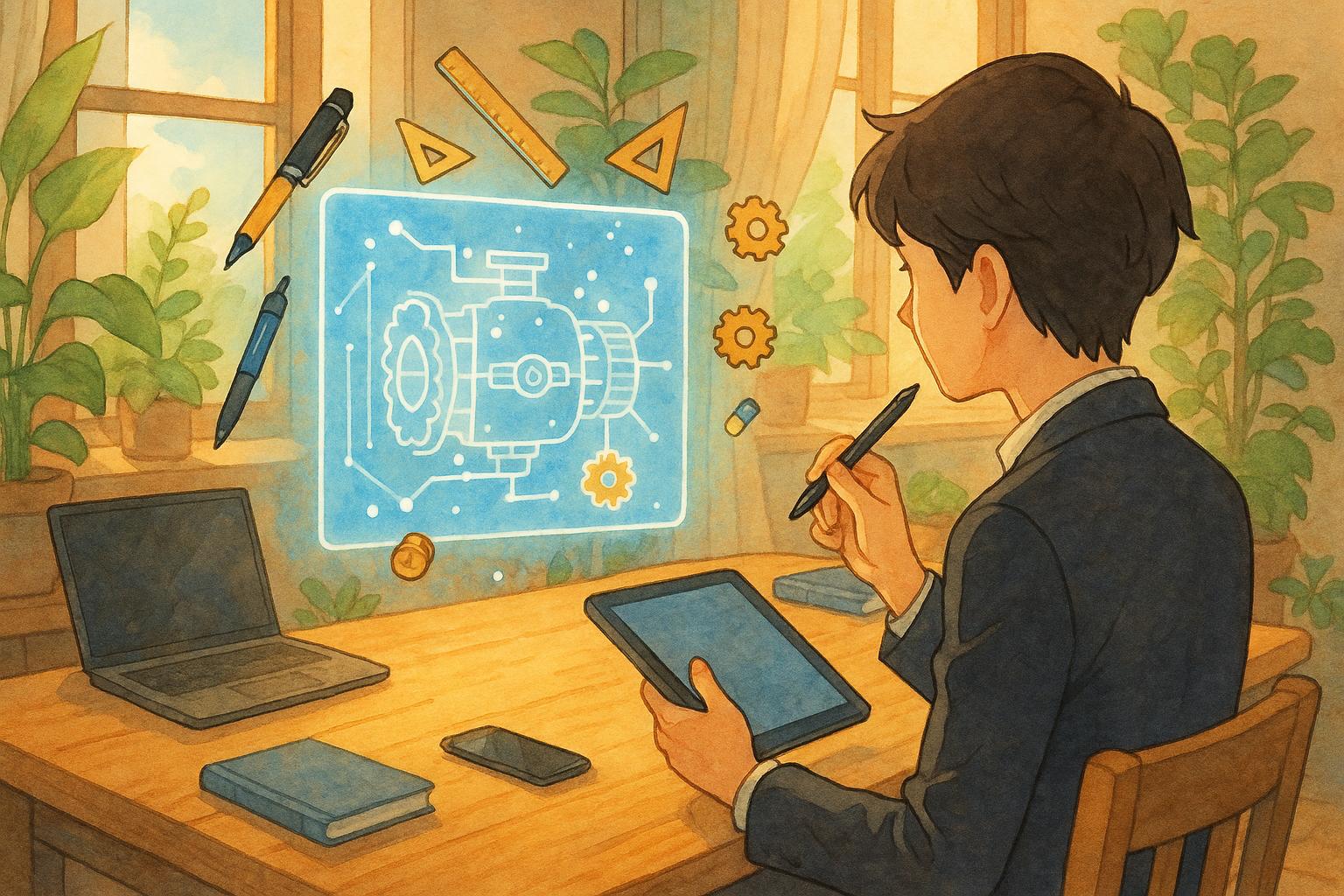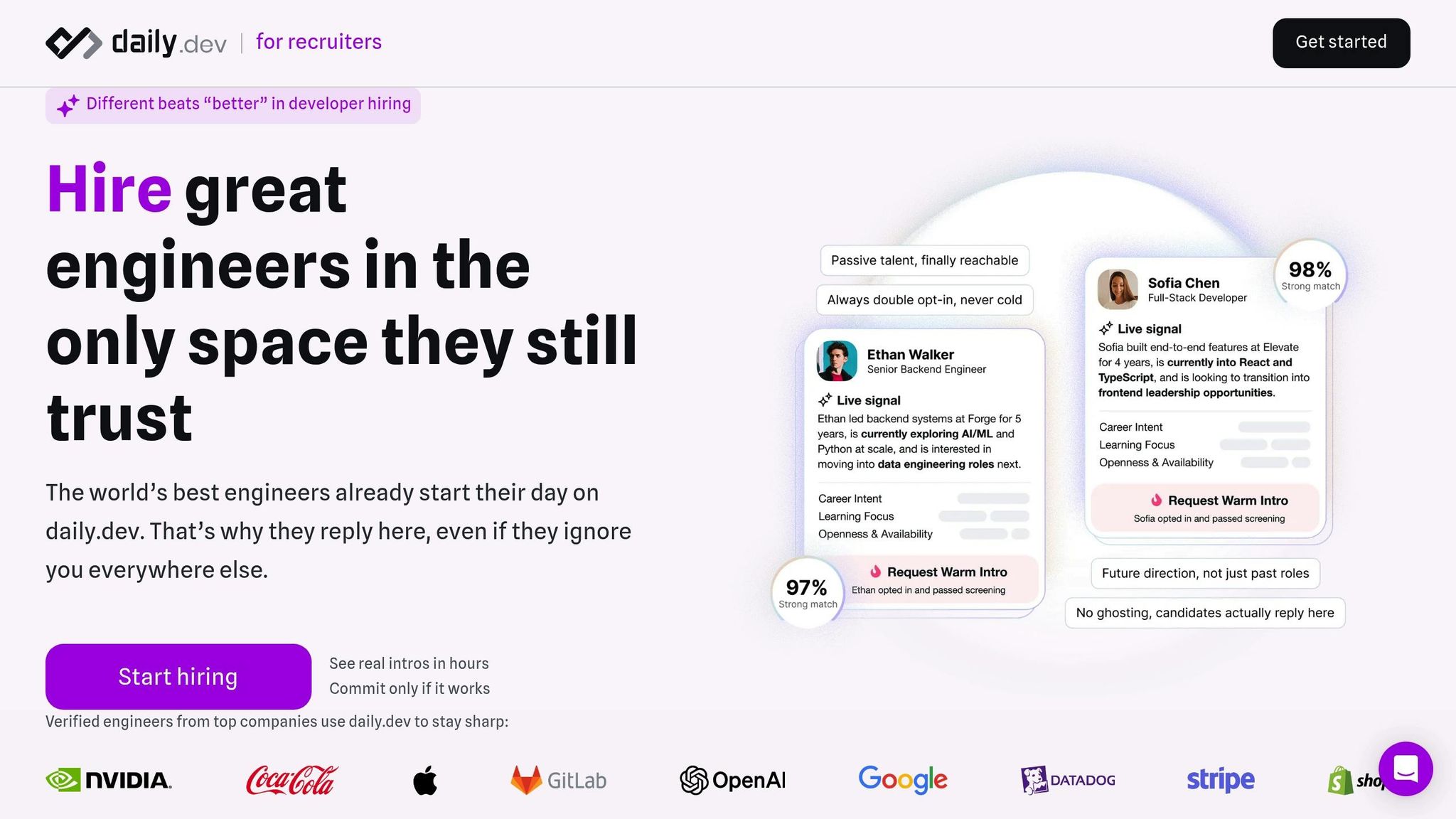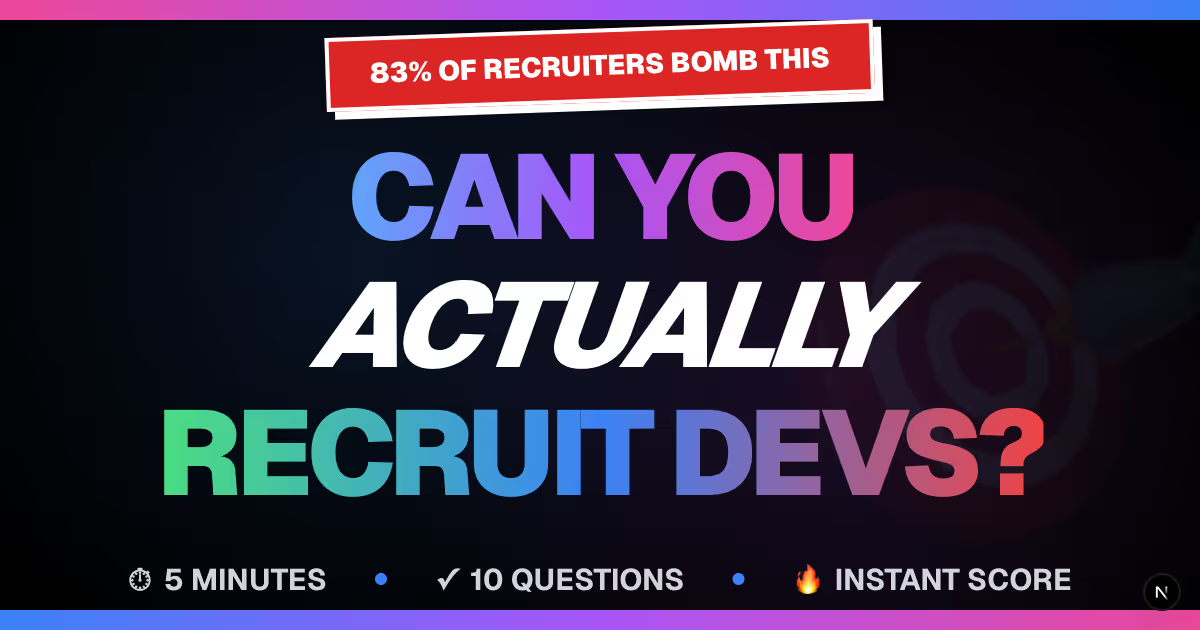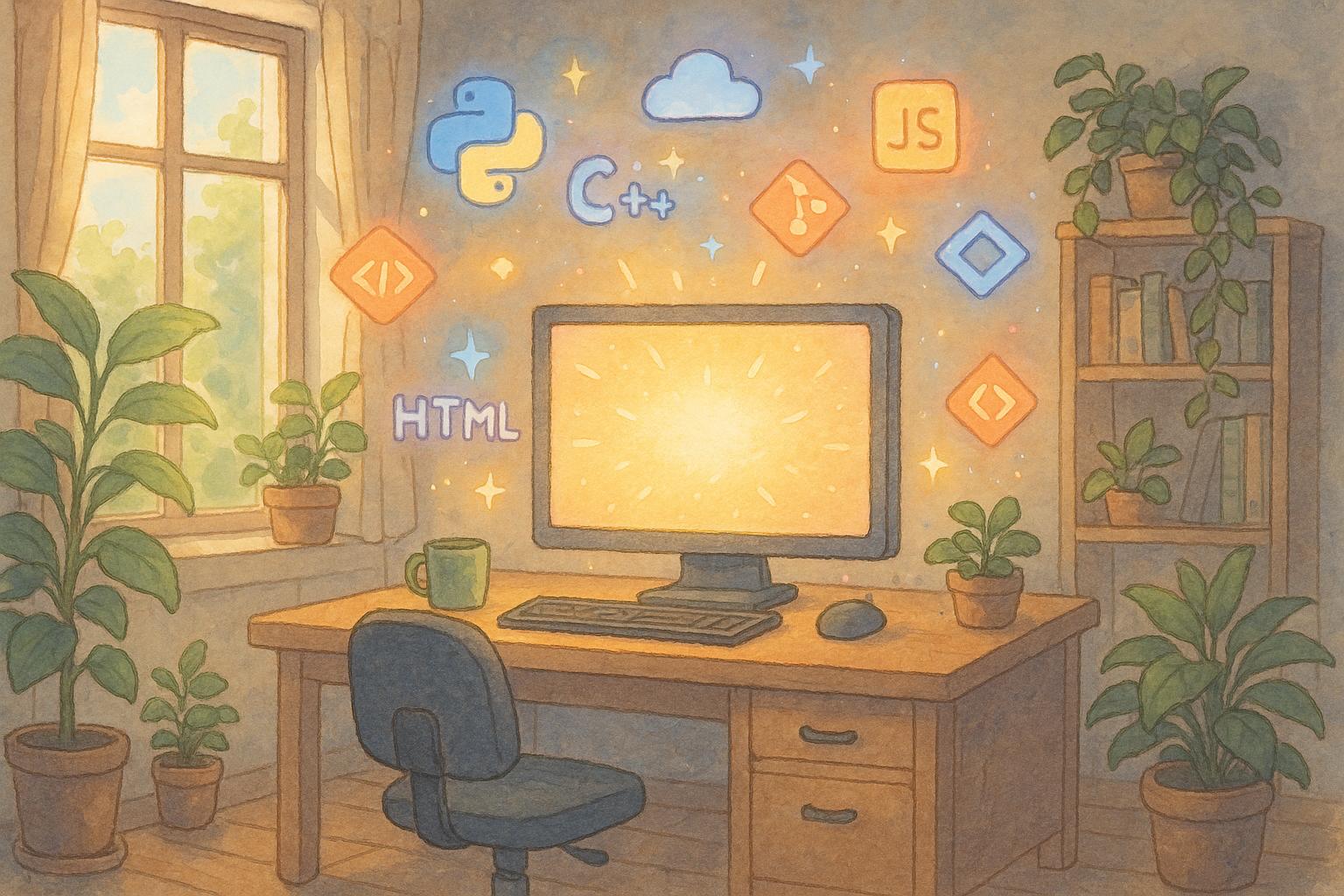


Learn how to effectively assess technical skills in candidates, ensuring better hiring decisions and greater team productivity.
Hiring developers can be tough - 73% of technical hires underperform compared to their interview results. Mis-hires lead to costly delays, extra workload for existing teams, and project setbacks. To avoid this, you need a structured approach to evaluate both technical and soft skills effectively.
Here’s how to ensure your hiring process identifies the right talent:
- Define the skills you need: Work with your engineering team to pinpoint must-have vs. nice-to-have skills.
- Use a skill matrix: Organize technical requirements, proficiency levels, and assessment methods for clarity.
- Choose effective testing methods: Combine live coding interviews, take-home projects, automated tools, and portfolio reviews to get a full picture of a candidate’s abilities.
- Leverage metrics: Track time-to-hire, assessment completion rates, and employee performance to refine your process.
Accurate skill assessment ensures better hiring decisions, reduces risks, and keeps your team productive.
Identifying the Technical Skills You Need
To build a strong team, you need to pinpoint the exact technical skills required for the role. This starts with understanding your team's unique challenges. Without their input, you risk focusing on skills that look impressive but don’t align with actual needs. The goal is to identify the expertise necessary to tackle your team’s specific technical hurdles.
The best way to approach this? Work closely with your engineering teams. These leaders know the technical details that can make or break performance in their environment.
Working with Engineering Teams
Collaborating with engineering leaders is key to identifying the technologies and technical requirements that are part of the team’s daily workflow. For instance, does the role demand advanced database optimization skills, or is basic SQL knowledge enough?
Set up focused discussions with hiring managers and senior engineers to clarify the immediate technical challenges the team faces. Together, you can outline the tools, frameworks, and experience levels required for the role. Is deep Python expertise critical for a backend engineer, or is it more important to have API design experience? Differentiating between must-have and nice-to-have skills ensures you assess candidates on what truly matters, rather than unintentionally filtering out strong prospects.
Engineering teams also provide insight into their development practices. A team that uses test-driven development will prioritize different skills than one focused on rapid prototyping. These details help you evaluate not just technical ability but also alignment with the team’s processes and working style.
Building a Skill Matrix
After gathering input, organize everything into a skill matrix - a structured framework that links technical requirements to specific assessment methods. This approach makes your evaluation process more organized and fair.
In your matrix, categorize skills by their importance and the level of proficiency required. For example, database expertise might involve crafting complex queries for one role, while another might only need a basic understanding of relationships. Be clear about what “proficiency” looks like for each skill in the context of the role.
Include both hard skills (like programming languages, frameworks, and tools) and technical soft skills (such as debugging, architectural thinking, and technical communication). Then, arrange these skills by how easily they can be verified and the time required to assess them. This helps you create efficient workflows that respect both the candidate’s and the interviewer’s time.
Finally, keep your skill matrix up to date. Technology evolves quickly, and what was crucial six months ago might no longer be relevant. Regular check-ins with engineering teams ensure your assessments remain current and effective. By maintaining this clear and structured framework, you’ll create a foundation for consistent and efficient technical evaluations across the board.
Effective Methods for Testing Technical Skills
Once you've built a clear skill matrix, the next step is choosing assessment methods that truly measure each technical requirement. A mix of approaches often works best, giving you a well-rounded view of a candidate's capabilities. Below are some effective strategies to evaluate the skills outlined in your matrix.
Live Technical Interviews
Live coding interviews are a great way to assess a candidate’s problem-solving abilities, how they perform under pressure, and how well they communicate technical concepts. Unlike written tests, these sessions let you see their thought process in action.
Focus these interviews on real-world scenarios instead of abstract puzzles. For example, if you're hiring a backend developer, ask them to design an API endpoint or debug a database query. This gives you a better sense of how their skills align with the job’s actual demands.
Keep the sessions concise - 45 to 60 minutes is usually enough to evaluate key skills without overwhelming the candidate. Let them use their own tools to work in a way that feels natural to them.
Pay close attention to how they explain their reasoning. Strong candidates will articulate their approach, ask clarifying questions, and weigh the pros and cons of different solutions. These communication skills are often just as important as technical expertise, especially in team settings.
Take-Home Coding Projects
While live interviews test quick problem-solving, take-home projects provide a deeper look at a candidate’s coding abilities over a longer period. These assignments often result in higher-quality work since candidates can complete them in a more relaxed environment.
Design take-home tasks that reflect real job scenarios and can be completed in 2-4 hours. Be transparent about the time commitment and provide clear instructions, including preferred tools or technologies. However, allow some flexibility so candidates can highlight their strengths.
For instance, instead of asking for a basic to-do app, you might request something like "build a simple inventory tracking system" or "design an API to process customer feedback." Assignments like these give candidates a chance to demonstrate practical problem-solving skills.
It’s important to avoid asking candidates to work on actual company projects or features you plan to use. This ensures ethical boundaries are respected and shows appreciation for their time and effort.
Automated Technical Screening Tools
Automated screening platforms provide a fast and consistent way to evaluate large numbers of candidates. These tools are particularly useful during the initial stages of the hiring process, helping you identify promising candidates before investing in more personalized assessments.
Modern tools can test a wide range of skills, from coding and system design to technical problem-solving. They use standardized criteria, which helps minimize bias and ensures a consistent evaluation - especially helpful when multiple team members are involved in hiring.
However, these tools should complement, not replace, human judgment. While they excel at assessing technical skills, they can’t evaluate communication, creativity, or team fit. Think of them as a way to narrow down your candidate pool rather than make final decisions.
Look for platforms that provide detailed feedback reports instead of just pass/fail results. This additional insight helps you tailor follow-up interviews and better understand each candidate’s strengths and weaknesses.
Portfolio and Open-Source Code Reviews
Reviewing a candidate’s existing work can offer valuable insights into their real-world coding habits and long-term project skills. Portfolios and open-source contributions often reveal more about their abilities than theoretical assessments.
When evaluating portfolios, focus on practical evidence of problem-solving, creativity, and analytical thinking. Pay attention to how their code is organized, the quality of documentation, and how they’ve tackled complex challenges.
Open-source contributions are another goldmine of information. Look at their commit history, pull request discussions, and how they respond to feedback. These interactions show not only their technical skills but also their ability to collaborate within a team.
If a candidate doesn’t have a formal portfolio, consider smaller projects, team contributions, or internal tools they’ve worked on. The quality of their thinking and execution often matters more than the scale of their work.
| Method | Signal Quality | Scalability | Candidate Experience | Implementation Complexity |
|---|---|---|---|---|
| Portfolio Reviews | High | Medium | High | Low |
| Live Coding Sessions | High | Low | Medium | Medium |
| Take-Home Projects | High | High | Varies | Low |
| Technical Discussions | Medium | Medium | High | Low |
| Automated Assessments | Medium | Very High | Low-Medium | High |
| Pair Programming | Very High | Low | High | Medium |
If a candidate lacks an extensive portfolio, don’t discount them. Smaller projects or personal experiments can still demonstrate their skills and potential. Often, the way they think and approach problems is more telling than the size or complexity of their work.
Improving the Assessment Process with daily.dev Recruiter

Finding skilled developers is one thing; connecting with them effectively is another. Many developers aren't actively searching for jobs, and traditional cold outreach often feels impersonal, making it hard to build meaningful professional relationships.
daily.dev Recruiter changes the game by embedding hiring directly into a vibrant developer community. Instead of relying on outdated resume databases, it connects you with engaged, pre-qualified candidates. Here's how it can enhance your recruitment process, from sourcing to seamless HR integration.
Developer-First Talent Connections
Cold emails and generic outreach often lead to low response rates. daily.dev Recruiter takes a different approach with its mutual double opt-in system. This means both parties - recruiter and developer - express interest before any interaction begins. The result? Every conversation starts with genuine enthusiasm and a clear understanding of the role and company.
By focusing on developers who are already active in their professional community, the platform ensures you're engaging with individuals who are passionate about their craft. This not only saves time but also increases the likelihood of finding candidates who are truly invested in the opportunities you offer.
Integration with US HR Workflows
daily.dev Recruiter seamlessly integrates with your existing ATS systems and recruitment tools, ensuring your current workflows remain uninterrupted. Whether you're using screening platforms, coding assessments, or scheduling tools, the platform acts as a reliable source of high-quality candidates to feed into your process.
For US-based companies, this integration is particularly valuable when hiring remote talent or expanding into global markets. The platform's transparent pricing structure also makes budgeting for technical hiring straightforward, eliminating surprises while giving you access to a global network of developers.
Clear and Developer-Friendly Experience
Beyond integration, daily.dev Recruiter prioritizes the developer experience. Job opportunities are presented in clear, technical language, creating a frictionless process that encourages candidates to engage. This approach leads to higher participation in take-home projects, technical interviews, and even feedback about their experience.
Since the platform connects you with developers based on mutual interest and active engagement, you're less likely to miss out on talented individuals who might otherwise slip through the cracks. Targeted role visibility further ensures your job postings reach developers with the right skills for your needs.
| daily.dev Recruiter Advantage | Impact on Candidate Evaluation | Traditional Recruiting Challenge |
|---|---|---|
| Warm, double opt-in introductions | Higher engagement from candidates | Low response rates from cold outreach |
| Pre-qualified developer network | Access to committed, skilled candidates | Screening unqualified applicants |
| Developer-friendly experience | Better participation in evaluations | High dropout rates during assessments |
| ATS integration | Smooth workflow continuation | Disconnected systems and manual data entry |
| Transparent pricing | Easier budget management | Hidden costs and complex pricing structures |
sbb-itb-d1e6221
Tracking Success and Improving Your Assessment Strategy
Creating effective technical assessments is just the start; the real challenge lies in refining your hiring pipeline using measurable results. By focusing on specific metrics, you can evaluate how well your assessment process is working and adjust accordingly.
Key Metrics to Track
- Time-to-hire: This measures how long it takes from the initial application to when the candidate accepts the job offer. Companies using AI-based assessment tools often report faster hiring times.
- Assessment completion rates: Keep an eye on how many candidates finish the technical assessments. If completion rates are low, it could indicate that your process is too complex or discouraging.
- Candidate satisfaction scores: Post-assessment surveys can provide insights into how candidates feel about the process. High satisfaction scores not only improve your reputation as an employer but can also lead to more referrals.
- Offer acceptance tracking: Monitor how often candidates accept job offers. A low acceptance rate might mean your assessments don’t align with the role or candidate expectations.
- Employee retention: Check retention rates at 6 and 12 months to see if your hiring process is leading to long-term success.
- Performance evaluation scores: Review how new hires perform during their probationary period. This can help you determine if your assessments are accurately predicting job success.
- Team integration success: Use peer feedback to gauge how well new employees adapt to their teams, especially for roles that require collaboration.
These metrics provide a strong foundation for identifying areas that need improvement.
Using Feedback to Improve Your Process
The data you gather from these metrics can guide updates to your hiring strategy. For example, compare assessment scores with actual job performance or analyze your recruitment ROI to ensure your process is both cost-efficient and effective.
Conclusion: Building a Reliable Framework for Technical Skill Assessment
Creating a dependable framework for technical skill assessment demands a thoughtful and systematic approach that keeps pace with the ever-evolving tech world. It’s not just about assessing candidates - it’s about building a process that strengthens your hiring decisions while staying relevant to new technological demands.
At the heart of any effective framework is a clear definition of required skills. Pinpoint the technical abilities your developers need right now. This isn’t a static task - since 2015, the skills required for the average job have shifted by 25%, and this figure is expected to double by 2027. Staying ahead means continuously revisiting and refining these definitions.
Your framework must also be adaptive and future-oriented, capable of evolving with emerging technologies. This involves refining interview techniques and designing take-home assignments that mirror the challenges your team faces in real-world projects. The goal is to ensure assessments remain relevant and practical.
To build on this foundation, data-driven decision-making is critical. Relying solely on intuition isn’t enough, especially when 73% of technical hires show a mismatch between their interview performance and actual job performance. Track key metrics like time-to-hire, assessment completion rates, and employee retention to pinpoint discrepancies. Use these insights to adjust your methods when assessment outcomes don’t align with on-the-job results.
The best frameworks also incorporate a continuous feedback loop. Use performance data and tracking tools to refine and improve your processes over time. This iterative approach ensures your framework remains effective as your organization’s needs change.
Interestingly, while 66% of HR leaders feel confident identifying the skills their teams need, only 48% know how to acquire them through hiring or development. A well-designed framework bridges this gap, turning assessment results into actionable hiring strategies. This creates a direct link between identifying skills and making informed hiring decisions.
Though building such a framework takes time and effort, the benefits are undeniable. You’ll make smarter hiring choices, reduce the risk of mis-hires, and improve the overall experience for both candidates and your team. The key is starting with a strong foundation and staying flexible enough to adapt as your goals and the tech landscape evolve.
FAQs
How can we keep our skill matrix relevant in the fast-evolving tech industry?
Keeping your skill matrix up-to-date is essential to stay aligned with evolving technologies and industry shifts. Make it a habit to collaborate with your team to discover new tools, frameworks, and practices they’re using or encountering in their daily work.
Take a closer look at past projects and contributions to identify the skills that prove to be consistently useful. Promote a culture of continuous learning by valuing candidates who actively seek to stay ahead of developments in the tech world. Their initiative can be a game-changer for keeping your team competitive and forward-thinking.
How can recruiters effectively combine automated tools and human judgment to assess technical skills during hiring?
Balancing the use of automated tools with human judgment is essential when evaluating technical skills. Tools like coding assessments and AI-powered screening software can efficiently filter candidates based on measurable factors like coding accuracy and efficiency. However, these tools should serve as a supplement to, not a substitute for, human evaluation.
Adding structured technical interviews and assessments of real-world projects can provide a clearer picture of a candidate's problem-solving approach, originality, and communication abilities. This blend of methods offers a well-rounded evaluation, helping to ensure that talented individuals who shine in areas beyond automated metrics are not overlooked.
What’s the best way to evaluate and improve our technical assessment process?
To fine-tune your technical assessment process, begin by monitoring essential metrics such as how candidates perform, their completion rates, and the time they take to finish assessments. Analyzing this data regularly can help you spot trends and pinpoint areas that need adjustment.
Work closely with subject matter experts to ensure the assessments genuinely reflect the skills required for the role. Make it a habit to update the assessments so they stay relevant to current technologies and industry shifts. It's also crucial to gather feedback from candidates about their experience. This can provide valuable insights to make the process more engaging and balanced.
By blending data analysis with expert advice, you can consistently improve your assessments, ultimately leading to stronger hiring results.
Related Blog Posts








